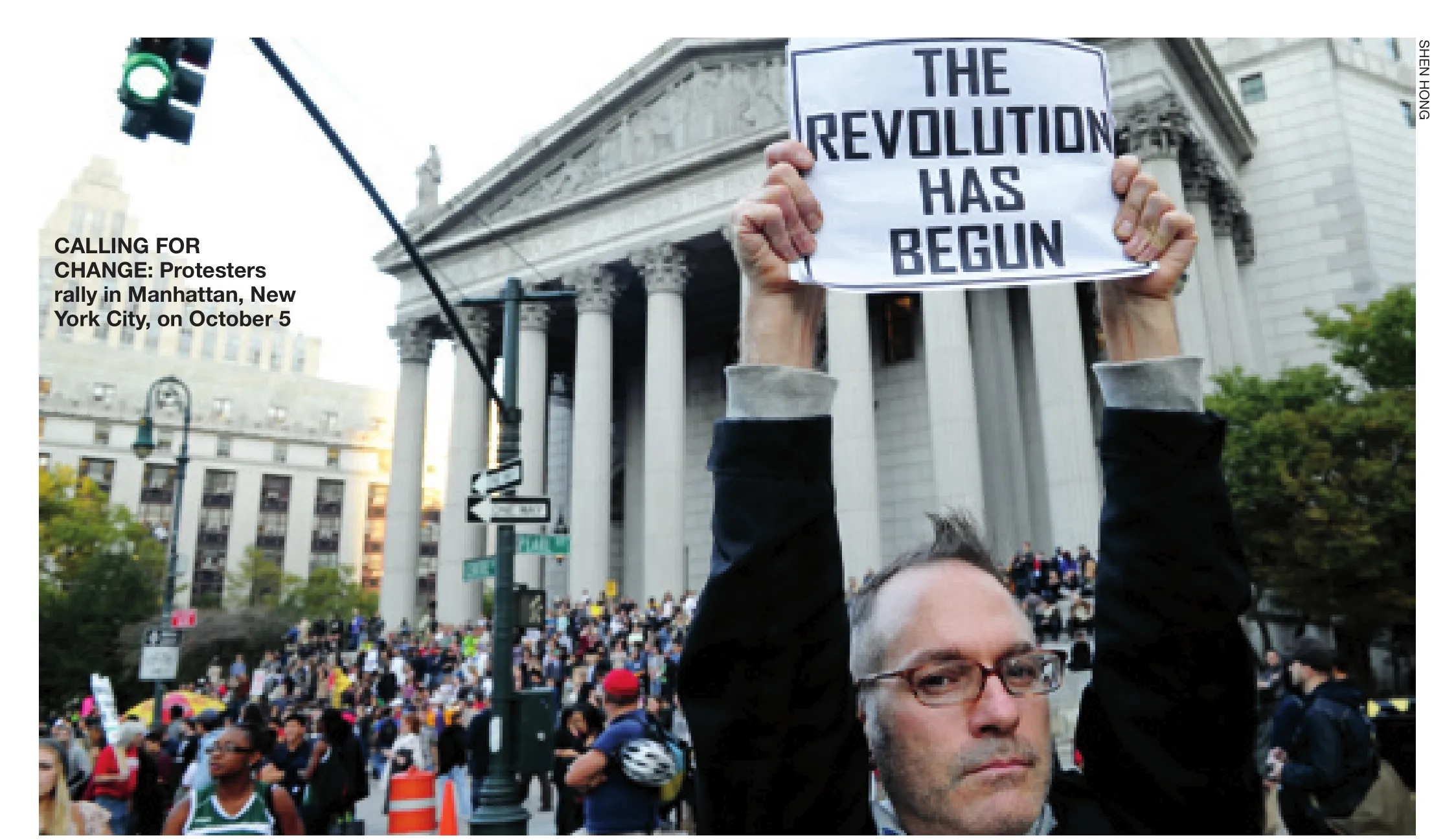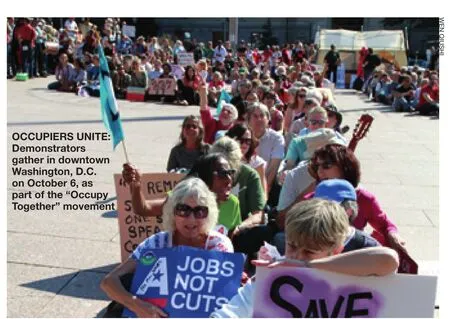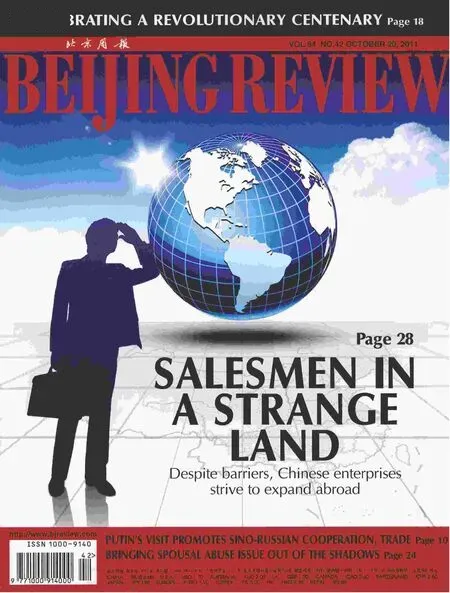American Occupation
By CHEN WEN
American Occupation
By CHEN WEN

Angry Americans across the country are protesting against inequality, greed and corruption
The “Occupy Wall Street” protests have grown from an insignificant lower Manhattan gathering of around 1,500 people to tens of thousands of people across the United States, from Anchorage,Alaska to Tampa, Florida. The protests started on September 17, denouncing the greed and recklessness of the financial titans who brought down the U.S. economy.
Protesters have different backgrounds in terms of professions, ages, political standpoints, ethnicity and religions. But at least they share one thing in common: They are not the rich. They call themselves the 99 percent.
“Make less than $1,137,684 a year?Congratulations! You’re one of the 99%,”said a poster in Zuccotti Park in New York City’s fi nancial district, where the protesters have established themselves.
They represent a variety of goals and demands, such as raising taxes on the rich and corporations, supporting trade unions,providing affordable healthcare, and dealing with global warming. But they shared common anger toward the ever-growing disparity in wealth and resource distribution, and the in fl uence of big businesses and the wealthiest on the government.
They are angry because they believe the richest 1 percent is taking almost 40 percent of the nation’s wealth while being taxed more lightly than the majority of Americans.They are angry because they believe their country is “unfair,” “failed” and “broken.”
Varied responses
As the movement continues to gain attention, some of the wealthy have tried to explain the story from the “1 percent” side.
According toThe Washington Post, a self-identified founder of a tech company wrote on a social news website called Reddit,“I am a multi-millionaire and member of the 1 percent. Do I think Wall Street is to blame?Yes and no. They cater to what people want.The real problem is politicians, who should regulate banking.”
But politicians themselves took different views toward the protesters. Independent Senator Bernie Sanders of Vermont appeared on Current TV’sCountdown With Keith Olbermannon September 29, supporting the protests. “We desperately need a coming together of working people to stand up to Wall Street. We need to rebuild the middle-class in this country,” said Sanders.
“I support the message to the establishment, whether it’s Wall Street or the political establishment and the rest, that change has to happen,” said House Democratic leader Nancy Pelosi in an interview with ABC News’This Weekon October 9.
However, on the same day, Republican presidential candidate and Florida businessman Herman Cain said on CBS’Face the Nationthat the protests are “class warfare” and “anti-American because to protest Wall Street and the bankers is basically saying that you’re anticapitalism.” He said some of the protesters are there because they don’t have jobs and that’s the problem of the Obama administration.
“We know that the unions and certain union-related organizations have been behind these protests that have gone on, on Wall Street and other parts around the country. It’s coordinated to create a distraction so people won’t focus on the failed policies of this administration,” Cain said.
U.S. President Barack Obama took a cautious attitude toward the protesters. At a news conference held on October 6, he said he understood the protesters’ concerns about the nation’s fi nancial system. “I think people are frustrated,” he said. “The protesters are giving voice to a more broad-based frustration about how our fi nancial system works.”
He also took the chance to criticize the Republicans. “What we’ve seen over the last year is not only did the fi nancial sector—with the Republican Party in Congress— fi ght us every inch of the way, but now you’ve got these same folks suggesting that we should roll back all those reforms and go back to the way it was before the crisis,” he said.
Root causes
It seems that the two political parties have always found it much easier to blame each other for problems rather than seeking compromise for solutions. This has added to the disappointment of angry Americans who are fed up with political brinkmanship.
The “Occupy Wall Street” movement“was not inevitable, but certainly necessary,”said Roxanne Dunbar-Ortiz, a professor emeritus with the Department of Ethnic Studies at California State University, East Bay.
“The causes for people rising up historically and currently are many, but it is not something that falls from the sky. Rather it has deep roots in the social order that is making life barely bearable for many,” Dunbar-Ortiz toldBeijing Review.
In the past 10 years, the United States has experienced a growing wealth gap and a shrinking middle class.
According to a CBS News report, the average middle-class family’s yearly household income was $49,445 in 2010, falling $3,719,or 7 percent from 10 years earlier. And the job market has been dismal. Statistics show that between 1999 and 2009, the net employment gain in the American workforce was zero.
Economist Jared Bernstein was quoted by CBS News saying the income of poor families decreased by 12 percent, dropping from $13,538 to $11,904 in the past decade, while the top 1 percent of earners enjoyed 65 percent of all income growth in the United States for much of the decade, “only brie fl y interrupted by the financial meltdown of 2008 and now, by the look of things, back on track.”
The financial crisis exposed long-term problems in the U.S. economy. Even though the government has tried to boost the economy, the situation has shown little sign of improvement.
Figures from the Bureau of Labor Statistics show that the U.S. unemployment rate has been around 9 percent since April. In September, the jobless rate was 9.1 percent,with 14 million people unemployed, among whom 44.6 percent had been jobless for 27 weeks or more.
Filling that job gap is key to recovery.President Obama proposed a $447-billion job bill, which included $78 billion in tax cuts for businesses, $105 billion for infrastructure projects, $175 billion to cut employee payroll taxes,and $54 billion for unemployment insurance and transitional work programs. But the Senate defeated the plan in a recent procedural vote.
Strength in numbers
Labor unions started to join forces with the protesters to complain about the unfairness of the economy, bringing even more momentum and media coverage to the movement.
Some argued that with big, established organizations like unions and political lobbies getting involved, this grassroots movement might face the challenge of building a broad coalition while avoiding connections with the old guard.

Analysts compared the leftist “Occupy Wall Street” movement to the conservative Tea Party. While Tea Party activists, many supported by top party leaders and donors,volunteered for Republican candidates, “it’s yet to be seen how the decentralized ‘Occupy Wall Street’ will respond to the attention from Democrats,” according to aBusiness Weekreport.
“I am not certain that the activities by the‘Occupy Wall Street’ group will have any impact. The reason that I suspect that there will be little impact is that the group doesn’t have any cohesive demands,” said Jennifer Blouin, an associate professor of accounting with the Wharton School of the University of Pennsylvania, during an interview withBeijing Review.
Her colleague Lawrence Gelburd is more optimistic about the power of the crowd.Three weeks are not usually enough time to enact social or political change in the United States, Gelburd toldBeijing Review. “But there is potential in the longer term,” he said.
The campaign could lead to changes in U.S. laws and in corporate behavior, but the likelihood of this depends on the “duration,intensity and media coverage,” said Gelburd.And the degree will depend on campaign organizers’ ability to articulate an overall set of principles as well as specific recommendations for change, he added.
The bright side of the movement,Gelburd pointed out, is that “peaceful protests give citizens the opportunity to have their opinions heard by a large audience.”
Dunbar-Ortiz said the widely spreading protests are the beginning of a process in the United States initiated by young people who have been inspired during the past year by resistance movements in North Africa, and in Spain,Greece and the UK.
The movement “will continue and grow and mature, developing a culture of resistance,” she said.
How much longer will the protests last and how will they develop? Jin Canrong, Deputy Dean of the School of International Studies at the Renmin University of China predicted three possibilities.
The protesters may end the “occupation”as the weather gets cold, since there is no clear cohesive demand and there is lack of leading organizer, Jin toldBeijing Review.They may disband for a while and come back again next year. Or they may turn into a powerful movement with the participation of unions or even political intervention, he said.
“If the movement escalates, there will be serious consequences,” Jin said. “It will accelerate the fragmentation of U.S. society and exacerbate economic problems.”
(Reporting in New York City, with additional reports from Ding Zhitao in Philadelphia and Yan Wei in Beijing)

